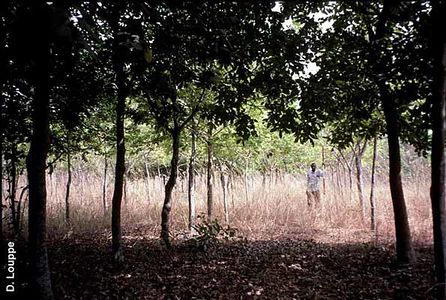Blighia sapida
Blighia sapida K. D. Koenig
| Ordre | Sapindales |
|---|---|
| Famille | Sapindaceae |
| Genre | Blighia |
2n = 32
Origine : Afrique de l'Ouest
sauvage ou cultivé
| Français | aki |
|---|---|
| Anglais | akee |
- arille du fruit comestible, à condition que le fruit soit mûr et ouvert
- arille immature ou trop mûre et graines toxiques
- importation interdite aux Etats-Unis
- ornemental
- arbre d'ombrage
- médicinal : fruit, graines, feuilles, écorce
Description
Noms populaires
| français | aki, fisanier, blighia savoureuse, fausse anacarde, pommier d’aki, arbre fricassé (PROTA) ; ris-de-veau (Martinique) ; cervelle végétale (Rollet) |
| anglais | ackee, akee, akee apple, savory akee tree (PROTA) ; ackee (Jamaïque) ; Jamaican ackee (est des Caraïbes) |
| allemand | Aki |
| néerlandais | aki |
| espagnol | akí, seso vegetal |
| portugais | castanheiro de Africa, castanha de Africa, huevo vegetal castanha (PROTA) |
Classification
Blighia sapida K. D. Koenig (1806)
Cultivars
Histoire
Usages
The fleshy arils are eaten fresh or used for many dishes after parboiling, cooking or frying. However, the fruit must be allowed to open fully or at least partly before it is detached from the tree. Unripe or overripe arils as well as the seeds contain hypoglycin and its derivative. They are strongly toxic. Dry seeds, fruits, bark, and leaves are medicinally used. Also much planted as shade tree and for ornamental purposes. Probably a domesticate of tropical W Africa and of Congo basin. Introduced to Jamaica by Captain Blight in 1793 to furnish food for the slaves, and spread to other tropical American countries. Importation has been banned by the US Food and Drug Administration.
Références
- Chauvet, Michel, 2018. Encyclopédie des plantes alimentaires. Paris, Belin. 880 p. (p. 676)
- Eyog Matig, O., Ndoye, O., Kengue, J. et Awono, A. (eds), 2006. Les Fruitiers Forestiers Comestibles du Cameroun. Rome, IPGRI, CIFOR, IRAD. XIV-204 p. Voir l'article
- Rollet, Bernard et coll., 2010. Arbres des Petites Antilles. Tome 1 : Introduction à la dendrologie. 276 p. Tome 2 : Description des espèces. 866 p. + 46 pl. coul. + CD de photos sur l'anatomie du bois. Basse-Terre, ONF. Voir sur Pl@ntUse.


















